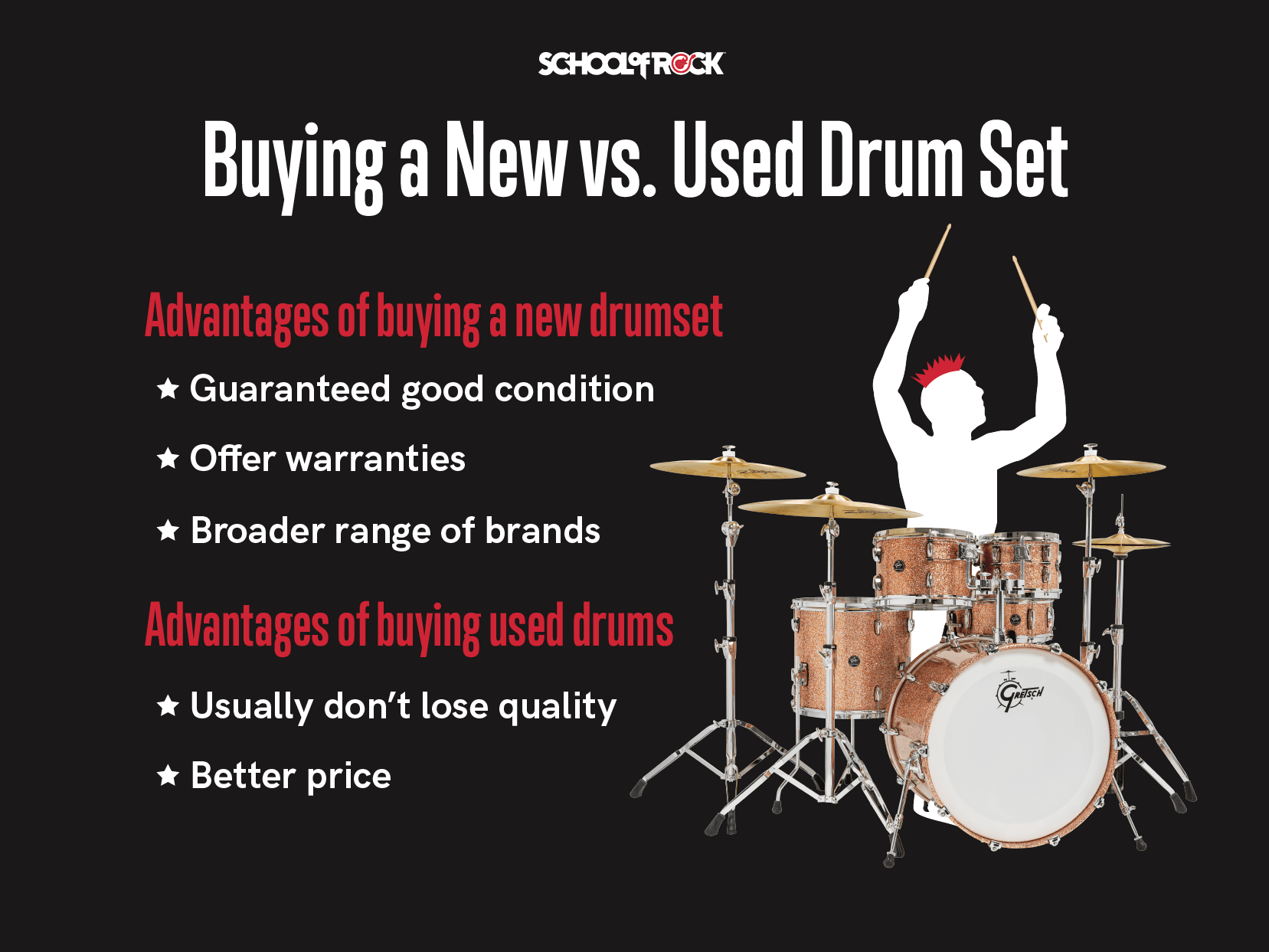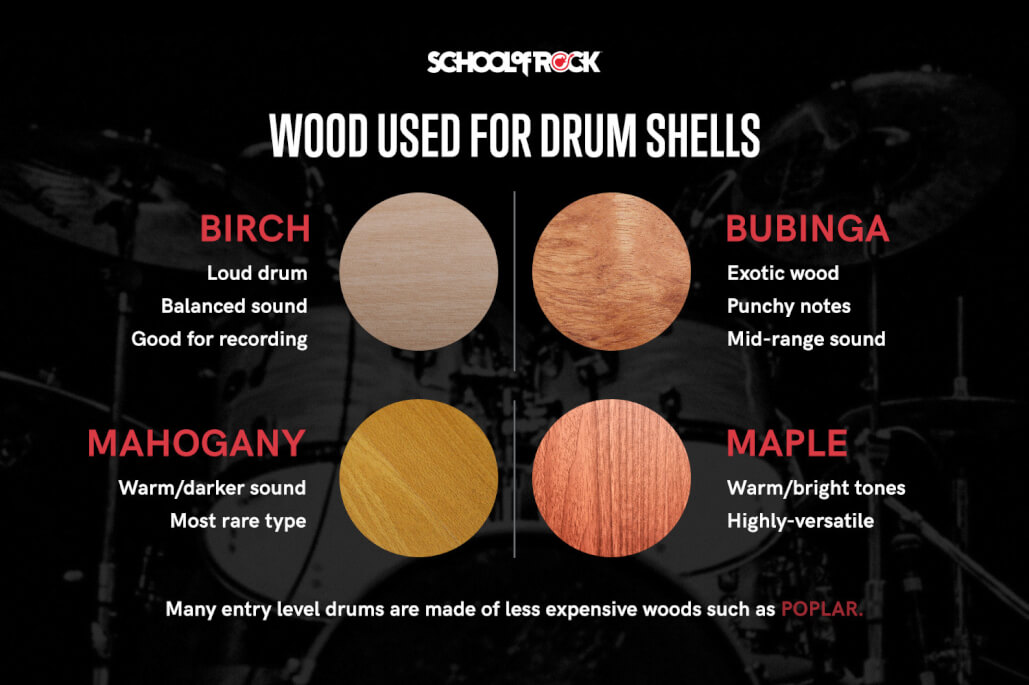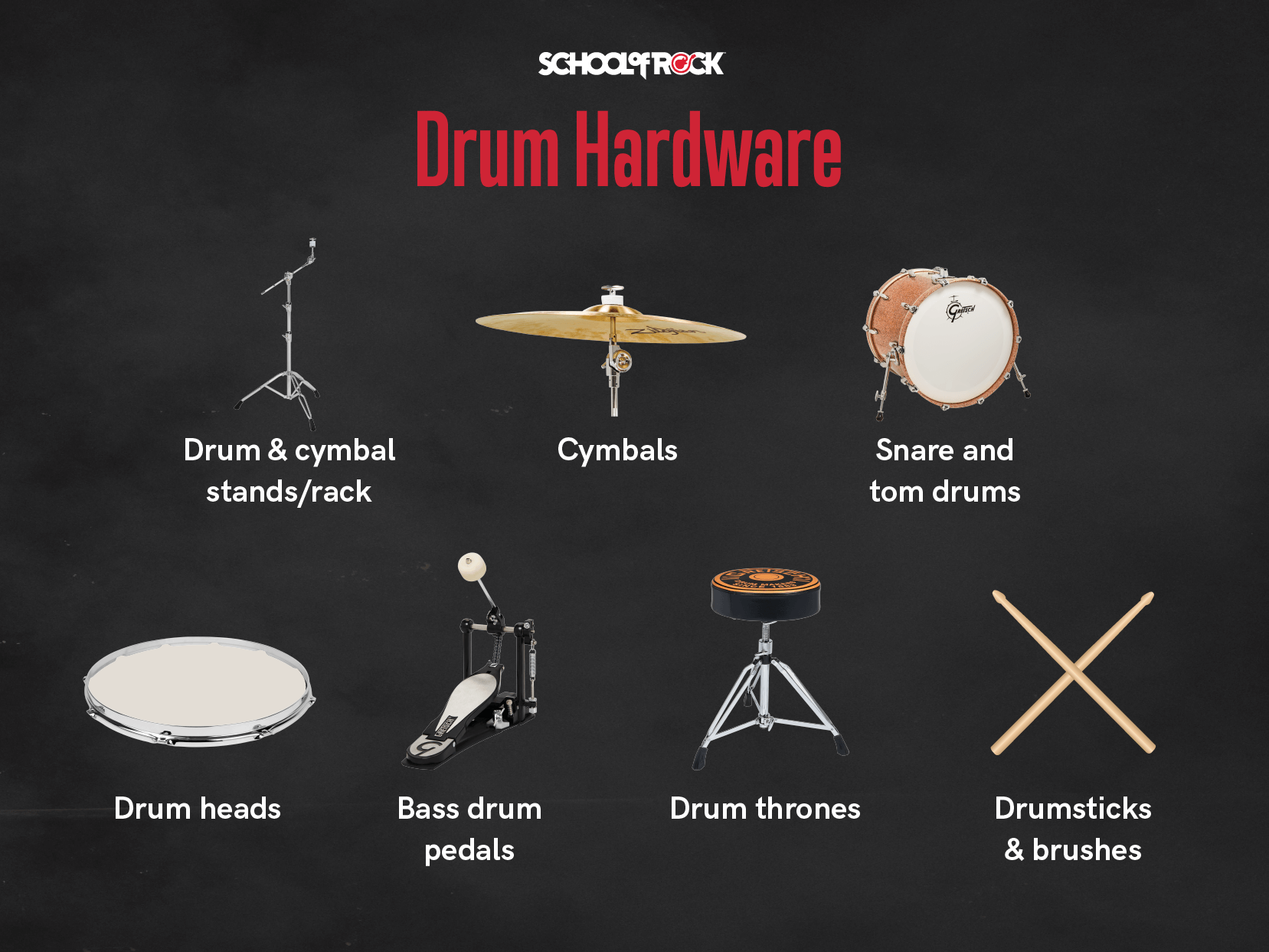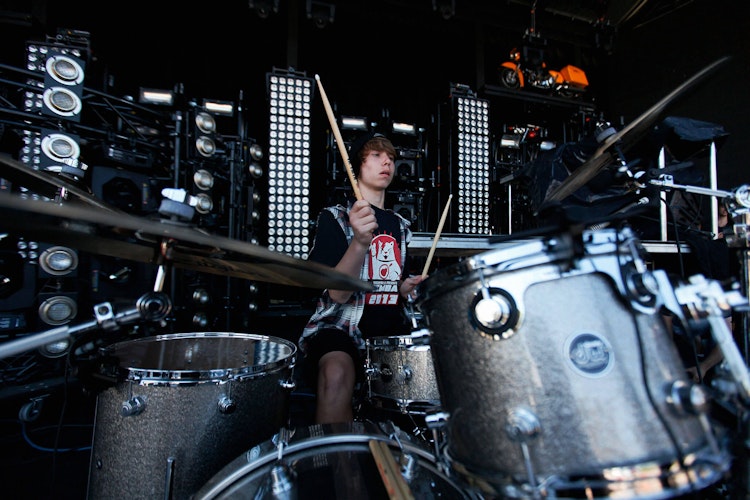The drummer is the heartbeat of any band, and they also own more pieces of gear than anyone else in the group. The good news is that you don’t need to own it all from day one.
Buying a drum kit for a beginning student can be overwhelming, so we’ve broken down what you need to know, from the types of kits to consider for a beginner to essential hardware that’s required to play the songs that will keep your student motivated.
Click below to jump to a section in the drum buying guide.
Shopping for a beginner drum set
The right place to start drum shopping depends on the person you're shopping for. You’ll want to consider the age of the drummer, their eagerness to learn, where and when they will practice at home, and the budget you’re working with.
Unlike most other instruments, drums can be arranged in different ways and customized to the drummer’s style or preferences. Once you have your kit, our guide on how to set up a drum set will be a huge help.
A beginner drum set should look quite different from a veteran drummer’s. A kit for a beginning drummer should provide what they need to build fundamental skills without adding in hardware or pieces that only distract the student.
What to look for when buying drums
If cost is your main concern and you're shopping for a kid’s drum set for your student, you can find something inexpensive for her/him to bang around on. The least expensive option is an all-inclusive bundle, but you'll want to verify what's included in the package.
A drum set needs shells (the actual drums), cymbal stands, cymbals, bass drum pedal and a throne to be fully functional.
Make sure to try out any kit before you buy to make sure reach and size aren’t a problem.
Best drum sets for kids
If your beginning drummer is younger than eleven or twelve years old, they may have trouble reaching and playing everything on an adult sized drum kit. Manufacturers make junior sized kits where drum diameters have been scaled down to allow younger kids to reach all drums and kick pedals. Knowing the best age to start drum lessons can help you decide if a junior kit is right.
Make sure to try out any kit before you buy to make sure reach and size aren’t a problem. Avoid kits that are available in toy stores unless your child is five or younger. These may look like real kits, but the drums are likely plastic and they are little more than toys.
Most major drum makers sell junior kits or “pocket kits” that are appropriately sized for younger drummers. Your child will eventually outgrow a junior kit, but not quickly.
What drum sets are good for kids?
A junior kit can be set up differently as your student grows and you can expect them to play it until they’re twelve or so, depending on their size.
Here are some models we suggest for those who are not quite big enough for a full-size kit:
- Ludwig Junior
- Gammon 5-Piece Junior
- Rise by Sawtooth
Best beginner drum sets for adults
Major manufacturers make some kits that have great tone and that also fit the budget of an adult beginning drummer.
We suggest you take a look at the following models:
- Pearl Roadshow
- Pearl Export
- Gammon 5 Piece
- Tama Imperialstar
- Gretsch Catalina
Buying drums online
If you're shopping online, be sure to read the list of what's included. Some of these sets have more in the online photo than actually ships with the set.
- Consider price and quality. Like most things, the quality of the drum set will determine the cost. The least expensive all in one sets come with a couple of warnings.
The shells will be usable, but the cymbals and hardware will likely be a little flimsy, probably needing to be replaced in the near future if the kit gets regular use. But if what you're looking for is a mix of toy and instrument, maybe this is the right choice. - Research the drum hardware. Take a look at the hardware and make sure it looks solid. If you're shopping online, you can zoom in on the images of the gear for a closer. Each of the three legs on the cymbal stands should be made of two pieces.
If each leg is “one-ply”, so to speak, or the pieces that loosen and tighten look like standard hardware store wing nuts, you're probably going to have to replace that stand sooner than later. - Look for bundled hardware. You can also find bundled hardware and cymbal sets that tend to be less expensive than buying pieces separately. Pay close attention to the images and descriptions of the hardware if you're buying online and don't get anything “one-ply.”
Buying drums in person
If buying drums for a young person, you will want to make sure they sit behind the kit and try to reach all components. Once you’ve determined that they can reach everything, determine what kind of adjustments can be made as your student grows.
If you’re trying to decide between multiple kits, you should listen to them being played at full force. If you or your student are a beginner, ask the salesperson if anyone in the store can play the full kit. Most music stores are staffed by musicians, so this shouldn’t be a problem. Compare the overall tone of the kits to determine what you like best and keep your preferred style of music in mind. This will help you choose the best beginner drum set for the music you want to play.
You will likely be purchasing the model that has been on display, so examine it closely for any damaged heads, cracked cymbals, or scratches in the wood or finish of the drum shells.
Pro Tip: Transporting Drums
Transporting drums requires a lot of space, so make sure you are prepared to take them with you and have a place prepared to set them up at home. The store will also have drum cases for sale, but this will add to the overall cost and may not be necessary unless the drums are being moved a lot.
Buying a new vs. used drum kit
For beginners, should you buy new or used? While used drum sets can offer significant savings, first-time buyers may be overwhelmed by the options and choices. New kits offer many advantages including warranties and you know that the kit has not been abused.
New kits are probably a better option for the first time buyer, but if you have a drummer friend that is willing to help you with checking out the used kits, it may be worth the effort.

Buying a new beginner or kid's drum kit
There are a lot of options for shell packs that will get you a set of drums without hardware or cymbals. You'll get a broader range of brand and aesthetic options this way, and most brands and models should be totally decent.
To find the best drum brands for your kid, it's always wise to read up on the reputation of the brand and find any reviews of the specific product you're looking at. There will likely be more than one option at each price point, so choose something with a good reputation that your kid will think is cool.
1. Selecting a kid's drum kit that your child is excited about
One of the big concepts at School of Rock is that if we help our students love playing their instruments, they get better that much faster. Having a set of drums that looks cool and excites your kid's interest can make it that much more fun to sit down and play.
2. Buy drum hardware upfront
If you're shopping in person, the salesperson will tell you that it will save you money, in the long run, to buy decent hardware up front, and they're right. For cymbals, make sure you're getting something name-brand. Zildjian, Paiste, and Meinl are some of the better-known names, but not the only good ones.
3. Look for all-inclusive drum kits
The second tier of all-inclusive kits can be pretty decent and will save you from having to assemble a set from a la carte pieces. Just like the big guitar brands have affordable sub-brands, the big names in drums have entry-level models that are usually quality.
Many of the mid-range kits that include shells and hardware don't include cymbals or a throne, so be sure to look at that before you make a final decision.
If cymbals are included, make sure there's a brand name on them – you don't want cymbals no one is willing to claim. If you end up deciding to buy cymbals separately, there are loads of options – more info below.
4. Select the best drum kit for your needs
Most major drum companies produce great beginner kits. It is generally recommended that you stick to the best-known drum brands: Ludwig, Tama, Pearl, Slingerland, Sonor, DW/PDP, Gretsch, and Mapex are all trusted brands.
Buying a used beginner or kid's drum kit
Drums, cymbals, and hardware don't tend to lose quality with use unless they're mistreated, and you can find nice gear at a good price shopping for used gear. Most instrument stores will have used gear, and if you're in a shop with a good reputation you can feel pretty confident you're getting something in good condition.
How to inspect used drum equipment
You can also find good pieces from private sellers, just look closely at each piece. Here are some things to watch out for with used drum gear.
- Shells. Look closely at the shells for any cracks or missing hardware. Little screws and nuts can be replaced if the drum is sound, but if you're not getting a great deal, it's probably not worth replacing little parts. It's likely that used drums will need new heads (the parts that you hit). It's not difficult to change the heads on a drum set, but it's another potential cost to take into account.
- Hardware. For hardware, make sure none of the pieces that tighten and loosen are stripped and none of the pieces that should be straight are bent. Cymbal stands should have two felt discs for the cymbal to sit between and a piece to hold that all in place on the stand. Usually that top fastener screws down on top of the upper piece of felt, though some newer designs you can just pinch to release.
- Cymbals. Looking at used cymbals, every crack, no matter how small, will grow over time. Any crack in a cymbal you're considering buying is a sign to pass. Sometimes little cracks can appear along the circular grooves of a cymbal and be easy to miss, so look closely for that.
If the hole at the center of the cymbal is not a perfect circle, it's a sign of stress on the cymbal probably due to not being fastened on the stand properly. Also look for little cracks around the center hole as a sign of damage that will quickly lead to the cymbal sounding bad and being unusable.
Get realtime performance feedback
You don't have to practice the drums on your own. With the School of Rock Method app, you can get live feedback as you play to make practice smarter, not harder.
Check out the School of Rock Method
Types of drum kits
The drum is one of the simplest musical instruments ever invented, but since the introduction of synthesizers in the 70s and 80s, drummers have had the option of computerized electronic drums that can produce a wide range of sounds. Even if you decide to go with traditional acoustic drums, there are two types of drum kits to choose from. Our guide to the different types of drums covers this in more detail.
Many manufacturers produce each kit they make in two different configurations, fusion and standard. Fusion kits have toms with smaller diameters that produce a sharp punchy tone. But standard kits are best for rock. The larger tom diameters produce more volume and have a larger tone that mixes well with electric guitars.
Play the drums in real performances
Our music programs are taught by practicing musicians with the experience you need to learn to play. Perform live shows and develop your skills in a supportive learning environment for all skill levels.
Learn to play
Choosing an acoustic drum set vs. an electronic drum set
There are two types of drum sets, traditional (acoustic) drums versus electronic drums. There are advantages to each type of drum.
Traditional (acoustic) drum kits for beginners
Acoustic drums have metal cymbals and use wood and metal drums that are designed to project sound. Traditional drums have a better “feel” and are less complicated to set up.
What is an electronic drum set?
Electric drum kits have rubber pads that when hit send sounds to either an amplifier or to headphones. For this reason, they have the ability to reduce or eliminate the volume of the drums. For students living in apartments or anywhere where sound levels are a concern, electronic drums in a kid’s drum set are a great solution. This makes an electronic drum kit a great option for a beginner.
Choosing the best wood for your drums
Wood harvesting isn’t the free-for-all it once was, and drum and guitar manufacturers now face restrictions on the types of wood they can obtain. Some types of wood are now rare and used only in high-end models.
Maple is by far the most common type of wood used in drums, but you may also encounter birch, mahogany, bubinga, and other more common types of wood.
But the sound of your drums is influenced by many factors. The type of wood used is one of them, but other important factors include the number of piles (wood layers) in the drum shell, the diameter of the drum, and the depth of the drum.
With all of these factors at play, it’s best to avoid shopping for a particular type of wood. Instead, buy your drums based on how they sound, especially if it’s your first kit. But here are some basics so you’ll know what you’re likely to encounter.

What is a covered finish for wood drums?
In many cases, the wood grain of the drum shell isn’t even visible because the drum was given a covered finish. These drums come wrapped in a vinyl covering that both protects the wood and decorates the shell. This covering can even be changed to give new life and a different look to an old or damaged kit.
What parts of a drum set should you look for?
A drum set is made up of many elements, the main categories are drums, cymbals, and hardware. The drum set is a fairly modern instrument as it was developed in the early 1900s with the invention of the first foot pedal. This allowed a drummer to play more than one drum and produce a fuller sound. Prior to this, drummers stood or marched as they played single elements of the drum kit.
The ability to play multiple drums arranged in a kit requires additional setup time and knowledge. Once you have your kit, you’ll need to take time to learn how to set it up and break it down, making sure that all drums are secured in place and all hardware properly tightened and adjusted. This can take some time, so be sure to check out our guide to setting up a drum set.

DRUM HARDWARE INCLUDES:
- Drum & cymbal stands/racks. Cymbals and some types of drums have their own stands. These are adjustable and allow the drummer to position the parts of the kits exactly where they want them. “Rack” systems integrate the functions of several stands, these can be useful for elaborate kits with multiple drums and cymbals.
- Cymbals. There are three main types of cymbals: crash, ride, and hi-hats. The crash cymbals are used to accent songs while the ride cymbal tends to be a large, thick cymbal that produces a bell-like tone. The hi-hats are a pair of smaller thin cymbals that are activated by a foot pedal that makes them strike each other. The foot pedal is included with the hi-hat stand and does not need to be purchased separately. The hi-hats are also played with the sticks.
- Snare and Tom drums. The snare drum is the loudest and most prominent drum. The bottom, or resonate, drum head has a system of “snares” or thin wires that gives the drum its sharp sound. Generally, a drum kit will have three tom drums - a floor tom mounted on a stand, as well as a medium and high tom mounted to the set itself.
- Drum heads. All drums have heads, which will generally be included in your purchase. The top head (the one that is struck) is called a batter head and the other bottom head is called the resonant head. The heads are tuned with a system of “lugs” that circle the drum. Learning how to tune your drums is a key skill for any drummer.
-
Bass drum pedals. Bass drum pedals are used to play the bass or “kick” drum. There are two types of bass drum pedals: single and double. It is recommended that beginners start with a single pedal.
-
Drum thrones. The throne is the name of the drummer’s seat. The drum throne should be adjustable and comfortable, with the entire drum kit set up around it.
- Drumsticks & brushes. Drumsticks are a very important part of the drummer's sound. They come in different sizes and are made from different types of wood. The size of the stick and the type of tip (which can be wooden or plastic) produce different tones. Brushes are sticks that have fan-like metal or plastic brushes on the end. These produce a much softer, quieter sound.
What’s the difference between shell packs and complete drum sets?
When shopping for a drum set for your teenager or child, you also have the option of buying all parts of the drum set separately, as well as buying the parts of the individual drums separately. This is the approach that will take the most time on your part, but you can end up with better quality and potentially save some money, too.
When you buy a drum kit, you’ll get everything you need. But you can buy each drum individually and only the hardware you need for each.
This is a good option for someone who has experience and wants something that doesn’t already exist as a kit, like something that mixes elements of a fusion and standard kit.
You also have the option of purchasing shell packs, which include only the wooden drum shells. This is a good option for upgrading the shells on a kit that is otherwise complete.
Shell packs are a good option for upgrading a kit that is otherwise complete.
Choosing a 4-piece drum set vs. a 5-piece drum set
Most drum sets are packaged as either 4 or 5-piece kits. This refers to the number of drums, not the number of total parts of your drum set including hardware and cymbals.
- 4-piece drum kit: This beginner drum set typically includes a bass drum, snare, floor tom, and one mounted/rack tom.
- 5-piece drum kit: This drum set includes a bass drum, snare, floor tom, and two mounted/rack toms.
Either configuration will work for a beginner, it may be easier to navigate a 4-piece kit when starting out. Interestingly, most high-end “pro” kits are 4-piece sets versus 5-piece drum sets.
Adding more toms & cymbals to your drum kit
If you are familiar with drummers such as Neil Peart or Terry Bozzio, you may have seen really large drum sets with lots of drums and cymbals. For the beginner, a 4 or 5-piece kid's drum set is the best place to start. Larger kits take up a lot of space and are much more expensive. As you progress musically, you can always add more drums to the existing kit.
Found your perfect drum set? You’re ready to jam.
The last thing you want, once you've picked out the best beginner drum set for your kid, is to have it sit untouched for the rest of her/his childhood. At School of Rock, our music programs focus on teaching students to enjoy playing their instrument first and build the broader concepts of music on top of that foundation, using performance as the motivation and the payoff.
When students know that they're going to walk out on stage in a real rock venue and play a legit concert, the practicing tends to take care of itself.
We would love for your child to have all of the pieces in place the second they get their instrument – expert drum lessons, a concert to start rehearsing for, and a community of friends.
At School of Rock, we take total beginners and within a few short months have them performing on stage, going on tour, building confidence, and making lifelong memories and friendships with kids that love the same things they do.




